Samsung at CES 2019: 219-Inch and 75-Inch Micro LED Ultra-HD TVs Demonstrated
by Anton Shilov on January 11, 2019 3:00 PM EST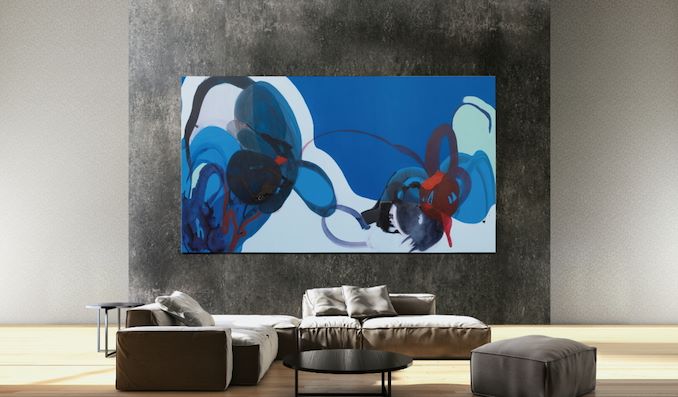
Samsung showcased its new ultra-large television with a 219-inch diagonal at CES 2019. Dubbed “The Wall”, the TV uses the company’s Micro LED technology that offers very high brightness and deep inky blacks, essentially competing against OLED TVs when it comes to picture quality. Separately, Samsung introduced its 75-inch Micro LED Ultra-HD TV aimed at general consumers.
The new 219-inch “The Wall” TV features an unknown resolution that is higher than 4K as well as 2,000 nits brightness. The television runs an unknown Samsung processor (presumably a version of the company’s Quantum Processor 8K that powers QLED-based Q900-series 8K UHDTVs) that supports the manufacturer’s AI upscaling tech along with other premium capabilities. Just like the Q900, “The Wall” can blend with surroundings to match style of the interior, a feature that Samsung is especially proud of. The TV can be controlled using a special tablet.
Meanwhile, the company’s prototype 75-inch Ultra-HD TV called “The Window” features a 4K resolution as well as a peak brightness of 1,000 nits. When “The Window” hits the market, its peak brightness will be increased to 4,000 nits, which is in-line with the Q900-series.
As the name implies, televisions based on the Micro LED technology use tens of millions of individually-controlled tiny LEDs (25M in case of “The Window”) that do not require any backlighting, which is why they can offer a very high contrast ratio. Samsung hopes that its Micro LED technology will be free of issues that OLEDs are known for (including off-axis color shifting, ghosting, burn-in, etc.), but will retain all of their advantages (brightness, contrast, fast response time, wide viewing angles, etc). As an added bonus, Micro LED screens do not need any bezels and can be made incredibly thin.
Samsung demonstrated its first 146-inch “The Wall” TV featuring 1,600 nits brightness at last year’s CES and released in mid-2018. The price of the device is unknown and it is believed that it is available to select customers only.
Related Reading:
- Samsung Starts to Take Pre-Orders on 85-Inch Q900 8K UHDTV
- Samsung Begins Sales of 65-Inch Q900R 8K UHDTV in the UK
- Samsung Announces CRG9: A 49-Inch Curved 5K 120 Hz FreeSync 2 Monitor
Sources: Samsung, Tom’s Guide, Tom’s Hardware, WhatHiFi


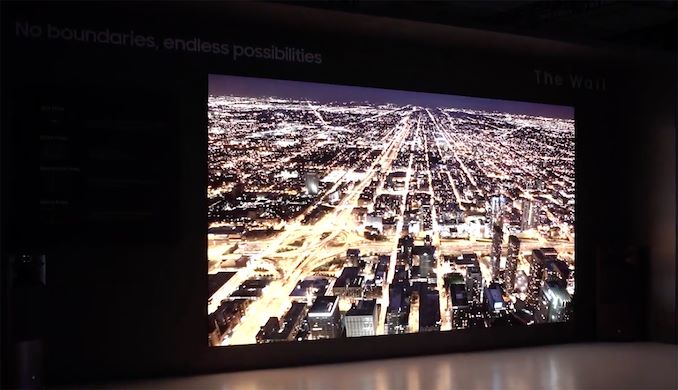
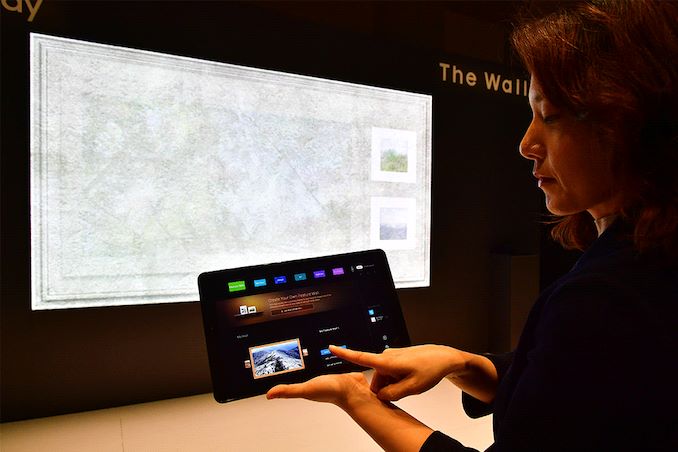
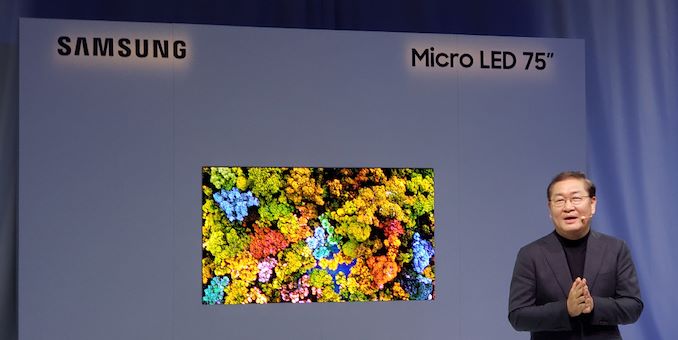
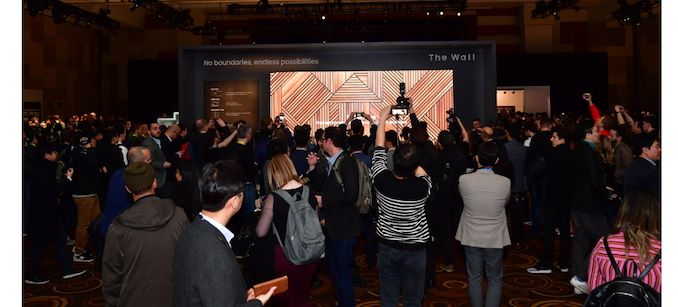








22 Comments
View All Comments
darkswordsman17 - Friday, January 11, 2019 - link
MicroLED should also be more efficient than OLED, especially with brighter content, and that'd be especially great for mobile devices and very large displays.For "The Wall" if they'd just gone with 16 (4 wide, 4 high) 55" 1080p resolution displays (for 220" diagonal) it'd have similar PPI, and I bet they could sell those individually to consumers - where they could upsell how you could just add more later to increase size and resolution so for 4K you'd buy 4 of them and have 110" display that would beat projectors in brightness and low light quality. But even 1080p with all the benefits of OLED and much less drawbacks, I think there would be a decent amount of people that would be interested. I know I would. And there's a decent amount of people that enjoy 1080p projectors at 100-120" where this would be an upgrade for them, while offering them the ability to have 4 individual 1080p displays if they might have that need (think of sports bars where when there's a bunch of games on they have separate displays, but then when its just one big one they'd have one big screen), or add more for an even bigger 8K display later on, but they could grow towards it.
Which, I like their modular approach in that it'd be more flexible on configuration. If you went vertical alignment it would better fit 2.35:1 content (4320x1920 = 2.25, so not quite but it'd be better fit than 16:9 7680x4320). And you could add displays as you can afford them or needed.
And if they could make the displays flexible, but not fixed, so you could make them concave or convex to fit the situation would be popular with digital signage.
deathwombat - Friday, January 11, 2019 - link
The 75" is "The Window", and the 219" is "The Wall". Presumably, this is a Get Low reference. I wonder how many people at CES have talked about the sweat dropping down their balls at this exhibit.teldar - Sunday, January 13, 2019 - link
What is get low?nathanddrews - Sunday, January 13, 2019 - link
http://lmgtfy.com/?q=get+lowI immediately thought of this track when I saw the press release. LOL
Kevin G - Friday, January 11, 2019 - link
I'm curious what the backend technology of the display is. Most of the traditional LED displays run a NovaStar based control system (with Planar and Barco doing their own thing). These systems can run high resolutions, I've help put together a 7680 x 2160 resolution wall but the base resolution for the system was 1920 x 1080 with a high end multi-view processor between the LED controllers and the content switcher to splice the 7680 x 2160 (or two UHD) source into eight 1920 x 1080 sections. Each section was composed multiple 135 x 120 pixels panels that linked to an aggregate board with multiple aggregate boards per section.Regardless, main point is that to drive crazy high resolution displays like this, their is typically a series of systems used to break down a single display source across source. While a single panel internally does something similar (even current 4K displays due similar processing to operate as four 1920 x 1080 panels), the additional reasoning for LED displays is the incredible size of the panel.
Samsung could have an in-house processor or one aspect of the system but I suspect that it isn't entirely their own.
Lolimaster - Saturday, January 12, 2019 - link
The issue seen with just a 75" demo unit is that initially it will be quite expensive and/or hard to shrink down microled no only for smaller TV's but also for monitors and worse for mobile devices.The near future approach for smaller display is using miniLED (based on microLED) to offer local dimming zones for smartphones/tablets as cheaper alternative to AMOLED, better if using with VA panels instead of IPS.
zodiacfml - Sunday, January 13, 2019 - link
I saw this idea probably one of the comments in youtube. I will be fine with LCD displays using large microLEDs as backlight, not as bright but a dark room can fix.Considering the cost of QLED displays, Samsung will charge an arm and a leg for microLED TVs.
valinor89 - Monday, January 14, 2019 - link
Hisense were demoing "ULED XD" where they use 2 LCD filter. A black and white 1080p filter worlks with the local dimming to efectively create a very fine and high contrast local dimming. Then a second 4k color filter creates the final image on top. Reportedly the contrast is near OLED levels and the technoclogy is quite cheap.namechamps - Monday, January 14, 2019 - link
Yeah despite the hype of bigger screens a more impressive demo would be say a 55" MicroLED. The problem with MicroLED is making them small enough. Current "MicroLEDs" are more like "mini-LED". That limits the dpi and thus how small the screen can be for a given resolution.vitalik - Sunday, October 27, 2019 - link
place where can dowload best games https://tech4blog.com/plague-inc-apk/